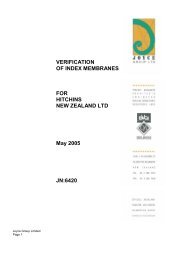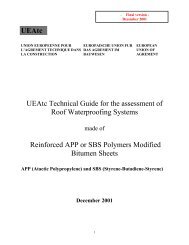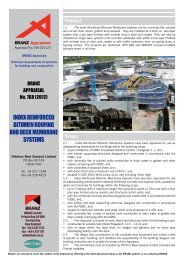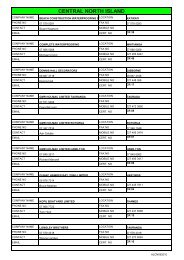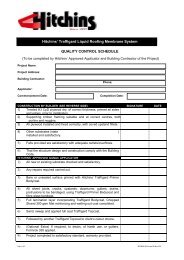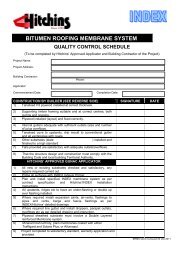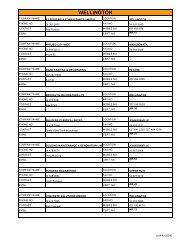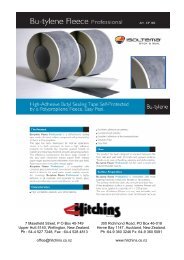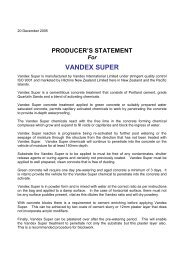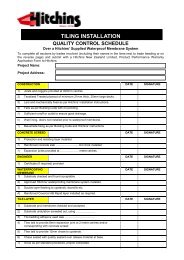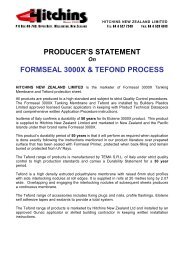TECHNICAL DOSSIER PROTEADUO TRIARMATO 4 mm ... - Hitchins
TECHNICAL DOSSIER PROTEADUO TRIARMATO 4 mm ... - Hitchins
TECHNICAL DOSSIER PROTEADUO TRIARMATO 4 mm ... - Hitchins
You also want an ePaper? Increase the reach of your titles
YUMPU automatically turns print PDFs into web optimized ePapers that Google loves.
<strong>TECHNICAL</strong> <strong>DOSSIER</strong><br />
OF<br />
♦<br />
♦<br />
♦<br />
PREFABRICATED MEMBRANE FOR WATERPROOFING<br />
MANUFACTURED WITH:<br />
Upper layer elastoplastomeric polymer-bitumen.<br />
Composite non woven polyester fabric impregnated with elastomeric polymer-bitumen.<br />
Lower layer elastomeric polymer-bitumen.<br />
Prepared in February 2000 as draft n° 01<br />
by<br />
INDEX S.p.A.<br />
Via G. Rossini 22<br />
Castel d’Azzano (VR)<br />
Italy<br />
For the following requested Cooperating Institutes:<br />
TZUS – Czech Rep.<br />
BBA – U. K.<br />
EMI Plc – Hungary<br />
Concerning the product:<br />
<strong>PROTEADUO</strong> <strong>TRIARMATO</strong> 4 <strong>mm</strong><br />
and<br />
MINERAL <strong>PROTEADUO</strong> <strong>TRIARMATO</strong><br />
Page n° 1 out of 24
INDEX<br />
<strong>TECHNICAL</strong> <strong>DOSSIER</strong>.....................................................................................................1<br />
1 st Section........................................................................................................................................................................... 3<br />
Manufacturer’s information............................................................................................................................................ 3<br />
2 nd Section.......................................................................................................................................................................... 3<br />
System’s information...................................................................................................................................................... 3<br />
2.1 General information.................................................................................................................................................. 3<br />
2.2 Characteristics........................................................................................................................................................... 4<br />
2.2.1 Bitumen................................................................................................................................................... 4<br />
2.2.2 Polymers ................................................................................................................................................. 4<br />
2.2.3 Filler........................................................................................................................................................ 4<br />
2.2.4 Reinforcement......................................................................................................................................... 4<br />
2.2.5 Self-protective slates............................................................................................................................... 5<br />
2.2.6 Metallic self-protection........................................................................................................................... 5<br />
2.2.7 Coating medium...................................................................................................................................... 5<br />
2.2.8 Membrane............................................................................................................................................... 5<br />
2.2.9 Auxiliary materials ................................................................................................................................. 7<br />
3 rd Section ........................................................................................................................................................................ 10<br />
Application’s information............................................................................................................................................. 10<br />
4 th Section ........................................................................................................................................................................ 21<br />
Production description.................................................................................................................................................. 21<br />
5 th Section ........................................................................................................................................................................ 22<br />
Quality control.............................................................................................................................................................. 22<br />
6 th Section ........................................................................................................................................................................ 23<br />
References .................................................................................................................................................................... 23<br />
Page n° 2 out of 24
1 st Section<br />
Manufacturer’s information<br />
INDEX Construction Systems Spa<br />
Research & Development Dept. manager Mr. Ugolini Augusto<br />
Quality Control Responsible: Mr. Aganetti Gianpaolo<br />
Via g. Rossini 22 Castel d’Azzano 37060 Verona (Italy)<br />
Tel +39-045-512233<br />
Fax +39-045-512528<br />
E-mail lab@index-spa.it<br />
The address indicated above is the same as the production site.<br />
Total surface of the production site is 56.000 m² of which 27.000 of them are covered. Index has 150<br />
employees.<br />
We began the production of PROTEA-DUO in 1988, and we have a potential for production of about<br />
7.200.000 m².<br />
Our actual total production is about 33.500.000 m².<br />
2 nd Section<br />
System’s information<br />
2.1 General information<br />
Trade name:<br />
PROTEA DUO <strong>TRIARMATO</strong> and MINERAL PROTEA DUO <strong>TRIARMATO</strong><br />
Composite waterproofing membrane manufactured from:<br />
♦ Upper layer elastoplastomeric polymer bitumen<br />
♦ Composite “non woven” spunbond polyester fabric impregnated with elastomeric polymer-bitumen<br />
♦ Lower layer elastomeric polymer-bitumen.<br />
DESCRIPTION<br />
<strong>PROTEADUO</strong> is a composite waterproofing membrane where the reinforcement is impregnated with SBS<br />
bitumen. The lower face which comes into contact with the substrate is made from SBS modified bitumen<br />
while the upper face is made from the APP modified bitumen The elastomeric coating medium of the lower<br />
face contains distilled bitumen and thermoplastic rubber made from a block copolymer radial, styrenebutadiene-styrene.<br />
The elastoplastomeric coating medium, which makes up the protective layer of the upper face of the<br />
membrane, contains distilled bitumen, atactic polypropylene, isotactic and polyolefinic elastomers resistant to<br />
U.V. rays, with added stabilisers for thermal shock, and a softening point above 150'C.<br />
The reinforcement is also the result of careful researches into the strengthening of waterproofing<br />
membranes. As it is well known, non-woven" polyester , while being resistant and elastic, it is more sensitive<br />
Page n° 3 out of 24
to the temperature then the mineral fibers reinforcement and can be the cause of deformation of the<br />
membranes.<br />
The traditional use of the non woven polyester in combination with glass fibers solves the problem of stability<br />
but even at the application stage the bending of the membrane causes tiny breakages in the glass fibers,<br />
which can damage the bitumen covering.<br />
<strong>PROTEADUO</strong> TRIPLE REINFORCEMENT has a composite three-layer reinforcement, where the glass fibre<br />
fleece is contained between two layers of continuous strand "non woven" polyester. The glass fibre fleece<br />
guarantees dimensional stability and the bituminous mass is protected and reinforced by the ”non-woven"<br />
polyester. The dimensional stability of <strong>PROTEADUO</strong> is very similar to that of glass fibre reinforced<br />
membranes while maintaining the good elasticity characteristics of "non-woven" polyester avoiding, in this<br />
way, the bending problems due to the combination polyester-fiberglass mentioned above.<br />
The reinfocement is completely impregnated and coated in the elastomeric coating medium by an exclusive<br />
procedure, which guarantees absolute waterproofing, high tear and impact resistance and excellent elasticity<br />
even at low temperatures.<br />
The lower face of <strong>PROTEADUO</strong> is covered by an anti-adhesive Flamina film, which has high retraction when<br />
it comes into contact with the torch flame during application.<br />
The elastomeric layer ensures excellent adhesion on most ordinary construction materials, and on<br />
polymer-bitumen membranes<br />
2.2 Characteristics<br />
2.2.1 Bitumen<br />
Distilled bitumen coming from Agip’s refineries and others suppliers by heated tanks.<br />
Penetration at 25°C is between 180÷220 d<strong>mm</strong><br />
Softening point is between 35÷50°C<br />
2.2.2 Polymers<br />
PP<br />
Atactic polypropylene supplied from Huls<br />
Isotactic polypropylene supplied from Montell<br />
SBS<br />
Styrene-Butadiene-Styrene supplied from Shell<br />
2.2.3 Filler<br />
Limestone presenting a granule-size distribution that is 98% passing through a sieve with an opening of 80<br />
µ.<br />
2.2.4 Reinforcement<br />
Reinforcement’s Description:<br />
Composite three-layer reinforcement, where the glass fibers felt is contained between two layers of<br />
continuous strand "non woven" polyester. The glass fibre felt guarantees dimensional stability and the<br />
bituminous mass is protected and reinforced by the ”non-woven" polyester.<br />
Tolerances<br />
Mass per unit area g/m² 175 ± 15%<br />
Tensile strength Long/Trasv N/5cm 405/405 ± 20%<br />
Elongation at break Long/trasv % 28/28 ± 15<br />
Page n° 4 out of 24
2.2.5 Self-protective slates<br />
Granules slates.<br />
Granule-size is kept under control.<br />
2.2.6 Metallic self-protection<br />
Non applicable<br />
2.2.7 Coating medium<br />
APP-modified SBS-modified Tolerances<br />
Filler contents (Sohxlet) 10 % 8% ± 5<br />
Filler contents (ash) 5 % 5 % ± 5<br />
Softening point 150°C 115°C ± 5<br />
Penetration at 25°C 30 d<strong>mm</strong> ± 5<br />
Penetration at 60°C 150 d<strong>mm</strong> ± 20<br />
Elastic recover - 300 % ≥<br />
Flexibility at low temperature -15°C -25°C ≤<br />
2.2.8 Membrane<br />
Protea duo Min Protea Duo Tolerances<br />
Length 10.00 m ± 1%<br />
Width 100.0 cm ± 1%<br />
Thickness 4 <strong>mm</strong> 4 <strong>mm</strong> on the selvedge ± 5%<br />
Mass per unit area 4.4 kg/m² 5.4 kg/m² Mineral type ± 10% / ± 15%<br />
Tensile strength<br />
Long<br />
750 N75cm<br />
± 20%<br />
Transv<br />
650 N/5cm<br />
Elongation at break<br />
Long 50 %<br />
± 15<br />
Transv 50 %<br />
Dimensional stability<br />
Long -0.25 %<br />
≤<br />
Transv +0.10 %<br />
Tear resistance<br />
Long<br />
250 N<br />
≥<br />
Transv<br />
250 N<br />
APP-side<br />
SBS-side<br />
Flexibility at low temperature -15°C -25°C ≤<br />
APP/SBS<br />
Heat stability 100°C ≥<br />
Self protection slate 1000 g/m² ± 250 g/m²<br />
Top finishing<br />
Non woven Polypropylene Granule slate<br />
Texflamina (35 g/m²)<br />
Bottom finishing<br />
PEHD film thermo-fusible<br />
All the rolls are close with two tapes on which are described the name of the product, the type of<br />
reinforcement and the thickness.<br />
Each roll is identified by a ticket control which is registered on the quality control report and lets, the quality<br />
control service, know all the information about the production of the material.<br />
Page n° 5 out of 24
TRANSPORT<br />
Rolls of the waterproofing material are grouped on pallets and covered with thick, shrink-wrap polyethylene<br />
sheeting. However, long journeys on bumpy roads or sharp braking, especially during su<strong>mm</strong>er months or on<br />
a long trailer, can cause the rolls to tip over. Ropes tied between the rows and across the sides of the trailer<br />
can prevent this occurrence. The ropes should be pulled tight and padded so as not to leave imprints on the<br />
rolls.<br />
LOADING / UNLOADING<br />
INDEX membranes are made to resist the mechanical stress they undergo during application. However,<br />
handling operations should be carried out with care to prevent squashing or contact with sharp or pointed<br />
surfaces. During low temperatures, sharp impacts should be avoided which may cause the membrane to<br />
break.<br />
STORAGE<br />
The materials should be stored under cover. The rolls should always be stored vertically on a smooth, flat<br />
surface except for those supplied with a rigid, internal reinforcing roll or support which can be placed<br />
horizontally for a limited period under cover. Also under cover, pallets can be stacked two high provided<br />
wooden planks are interposed to distribute the weight evenly.<br />
HANDLING ON SITE<br />
Only keep on site the number of rolls necessary for the day's use. Place the rolls upright on a flat, smooth<br />
surface. Use a crane and suitable lifting attachment to lift the rolls onto the roof on a pallet in good condition.<br />
If it is necessary to open the packaging and lift the rolls onto the roof separately, use the correct crane<br />
accessories, then stand the rolls upright. Do not use ropes to tie and lift the rolls.<br />
CONSERVATION<br />
Pallets should be stored in a dry location out of direct sunlight. During su<strong>mm</strong>er, pallets with shrink-wrap<br />
covers left in the sun can quickly reach temperatures of 70°C and that causes progressive blackening of the<br />
surface or slate chips on the rolls from the top to the bottom until the membrane starts to stick to itself or until<br />
it looks unattractive.<br />
If it is necessary to store pallets in the sun, even for short periods, it is better to remove the covering<br />
completely or at least to make slits in the sides for ventilation and protect the top with wooden planks or<br />
laths. In wintertime the rolls should be left in a temperature above +5°C for 24 hours before laying but should<br />
not be left in the open-air overnight. Only those, rolls that are to be laid during the day's work should be<br />
taken to the site. A good practice is to always take the oldest rolls from the store and not to leave any rolls<br />
stored for more than 12 months.<br />
Page n° 6 out of 24
2.2.9 Auxiliary materials<br />
INDEVER<br />
BITUMINOUS SOLUTION CONTAINING BITUMEN AND QUICK-DRYING SOLVENTS<br />
INDEVER MOTORWAYS<br />
BITUMINOUS SOLUTION CONTAINING BITUMEN AND OUICK-DRYING SOLVENTS SUITABLE<br />
FOR APPLICATION ON DAMP SURFACES<br />
DESCRIPTION<br />
INDEVER is a bituminous primer made from a mix of solvents and oxidised bitumens. If applied as a thick<br />
waterproofing paint, when dry, INDEVER leaves a strong anchorage on every type of substrate without any<br />
degree of surface stickiness. It also has excellent penetration, adherence and consolidation properties when<br />
applied to dry concrete surfaces.<br />
INDEVER MOTORWAYS is a bituminous primer made from a mix of solvents, oxidised bitumens, and<br />
selected additives to improve anchorage to even damp concrete decks. INDEVER MOTORWAYS complies<br />
with technical motorway specifications for applications on concrete bridges and viaducts before polymer<br />
bitumen membranes are applied.<br />
APPLICATIONS<br />
INDEVER is suitable for saturating a cement deck in addition to preparing an excellent anchorage for<br />
bituminous waterproof coverings or polymer-bitumen membranes.<br />
INDEVER fixes superficial cement dust providing excellent adhesion of the waterproofing layers, which<br />
require strong, permanent adhesion to the support.<br />
INDEVER is specifically used for applications on dry concrete viaducts and bridges before a bituminous<br />
polymer membrane is laid down.<br />
INDEVER MOTORWAYS performs all the same applications as INDEVER primer but is specifically designed<br />
for use on damp surfaces.<br />
DIRECTIONS<br />
Preparation of the concrete substrate<br />
For best results, the concrete surfaces to be treated should be as dry as possible where INDEVER primer is<br />
used and slightly damp where INDEVER MOTORWAYS primer is used. All surfaces must be perfectly clean<br />
without loose particles and free from oil, grease and dust.<br />
APPLICATION<br />
Both INDEVER primers are ready to use and do not need diluting; they are applied by brush, broom or<br />
spray.<br />
The quantity of INDEVER primer to be used depends on the surface porosity and the type of finish of the<br />
surface to be treated. Polymer-bitumen membranes may be applied after a drying time, which varies from a<br />
minimum of three hours, in situations exposed to the sun, up to eight hours in diverse conditions.<br />
Consumption per coat on cement surfaces: 350-500 g/m² Consumption per coat on metal surfaces: 200-300<br />
g/m².<br />
Page n° 7 out of 24
INSTRUCTIONS<br />
- Operators should be equipped with protective gloves and goggles during application.<br />
- Observe all safety regulations carefully.<br />
- In enclosed surroundings, use suitable breathing apparatus and ensure as much ventilation as possible.<br />
STORAGE<br />
- Store INDEVER primer in places suitable for infla<strong>mm</strong>able materials.<br />
- Keep the product out of direct sunlight and away from heat sources.<br />
SAFETY REGULATIONS<br />
R11 Easily fla<strong>mm</strong>able.<br />
R 20-21-22 Noxious if inhaled or ingested and when in contact with the skin.<br />
S3-9-49 Keep in original containers and in a cool place.<br />
S16 Keep away from flames and sparks.<br />
S23 Do not breathe fumes.<br />
S24/25 Avoid eye and skin contact.<br />
S29 Do not dispose of residues down the drain.<br />
S36/37 Wear protective garments and suitable gloves.<br />
S38 In case of insufficient ventilation, use suitable breathing apparatus.<br />
S51 Only use in well ventilated surroundings.<br />
<strong>TECHNICAL</strong> CHARACTERISTICS<br />
INDEVER<br />
INDEVER MOTORWAYS<br />
APPEARANCE Black liquid Black liquid<br />
SPECIFIC WEIGHT 1,00 ± 0.1 kg/l 1,00 ± 0.1 kg/l<br />
DRY RESIDUE 43 ± 3 % 50 ± 1 %<br />
FORD VISCOSITY 4 at +20°C 14” ± 3” 22.5” ± 2.5”<br />
DRYING TIME (dust dry) 30 ÷ 60 minutes 30 ÷ 60 minutes<br />
DRYING TIME (touch dry) 100 ÷ 140 minutes 100 ÷ 140 minutes<br />
SHELF LIFE (in original containers) 2 years 2 years<br />
INDECOLOR<br />
Water based protective and decorative coating for use on bituminous waterproofing.<br />
Indecolor is a waterproofing paint containing polymers dispersed in water with internal plastification. Once<br />
dried, Indecolor forms a flexible tough skin, which adheres well to polymer-bitumen waterproofing<br />
membranes.<br />
Application may be carried out by brush, broom or spray. Surface to be painted must have a slope of at least<br />
3% to allow rainwater drainage; Indecolor is not suitable for finishing flat roofs where ponded water may be<br />
present.<br />
For a good result it is necessary to apply two coats of Indecolor paint. The second coat should only be<br />
applied after the first coat has dried; this is usually after approximately 24 hours.<br />
Coverage per coat is about 300 g/m².<br />
Colours<br />
White, grey, red, brown, green<br />
Appearance<br />
Coloured paste<br />
Specific weight at 20°C<br />
1.45 ± 0.05 kg/l<br />
Dry residue 63± 3 %<br />
Page n° 8 out of 24
SOLARIS<br />
Solaris is a paint containing a particularly fine metallic aluminium powder, resins, polymerised oxidised<br />
bitumen, plasticisers which do not seep, reflective fillers and special solvents. Solaris is a brilliant silver<br />
colour and is of fluid consistency.<br />
Once dry, it forms a waterproofing protective film, which reflects the sun’s rays, contributing appreciably<br />
towards thermal insulation of the protected areas, and reduces solar heat build up inside the building.<br />
Solaris is ready to use and is applied by spry, roller, brush or broom. One coat is sufficient for complete<br />
coverage to provide a reflective surface to the bituminous surface, but two coats are reco<strong>mm</strong>ended where<br />
longer lasting and improved protection is required.<br />
Colours<br />
Silver<br />
Appearance<br />
Liquid<br />
Specific weight at 20°C<br />
1± 0.05 kg/l<br />
Dry residue 35± 3 %<br />
PERFOBASE<br />
Perfobase is a perforated reinforced glass fibre felt impregnated with polymer modified bitumen. A sacrificial<br />
polyethylene film protects both sides of the membrane, which is heat melted. The perforations, each 40 <strong>mm</strong><br />
diameter, are distributed evenly throughout the membrane, with 119 holes per square meter.<br />
It is use for to obtain a partially bonded surface evenly distributed, in which the area of adhesion is<br />
approximately 15% of the total surface. It allows vapour to disperse and movement of the deck under the<br />
waterproofing layer to take place without damage to either the Perfobase or the cap sheet.<br />
Weight<br />
Approx. 800 g/m²<br />
Number of holes / m² 119<br />
Diameter of holes<br />
40 <strong>mm</strong><br />
Perforated area Approx. 15%<br />
DEFEND 3 <strong>mm</strong><br />
Distilled bitumen modified with elastoplastomeric polymer bitumen waterproofing membrane reinforced with<br />
glass-fibre felt.<br />
HELASTA V 3 <strong>mm</strong><br />
Distilled bitumen modified with elastomeric polymer (radial styrene butadiene) bitumen waterproofing<br />
membrane reinforced with glass-fibre felt.<br />
HELASTA P 4 <strong>mm</strong><br />
Distilled bitumen modified with elastomeric polymer (radial styrene butadiene) bitumen waterproofing<br />
membrane reinforced with non woven polyester. Agreement certificate by ICITE n° 487/97.<br />
ADHERING<br />
Self adhesive membrane made with distilled bitumen modified with elastomeric polymer reinforced with<br />
glass-fibre felt. The bottom surface is protecting by an anti-adherent film, which has to be removed during<br />
the application. The topside is protecting by a thin polyethylene film, which is torch during the application of<br />
the top layer. The heat obtained from the application of the top layer melts the Adhering’s bottom compound<br />
and allows a very good adhesion with the substrates.<br />
Page n° 9 out of 24
ROLLBASE<br />
Polymer bitumen membrane reinforced with glass fibre felt and with the lower face finished with a non woven<br />
polyester , the top surface is protected by a PE film. Mass per unit area 2 kg/m², the width of the selvedge is<br />
5 cm and the dimensions of the rolls is 10 by 1.05 m.<br />
3 rd Section<br />
Application’s information<br />
Loose laid application<br />
By “loose laid” we mean application of waterproofing system completely detached from the substrate: this<br />
method cannot be used for slopes higher than 5%, as a heavy protection is always necessary (with gravel or<br />
concrete tiles); moreover, this system is advisable when the membrane is applied on thermal insulating<br />
panels. Perimeters and parapets and vertical walls are always fully bonded by torching. In case of doublelayer<br />
application, the second layer is fully torched to the first one, keeping the first layer staggered 50 cm<br />
from the second one.<br />
Partially-bonded application<br />
When “partially-bonded ” the waterproofing systems must be adhered using a predetermined ratio to give an<br />
even application over the total surface area. On concrete substrates, the surface has to be treated with a<br />
primer and spot-torched afterwards, in order to obtain a bonded surface for 50% of the whole. This way of<br />
application is advised for slopes up to 40%. Perimeters and parapets and vertical walls are always fully<br />
bonded by torching.<br />
Alternatively, we may suggest the use of perforated membrane “Perfobase” for slopes up to 20%; for higher<br />
slopes the use of mechanical fixing at the end of the roll is advised.<br />
In case of non continuous concrete substrates, in between the substrates itself, stripes of at least 20-cm<br />
width have to be mechanically fixed (and/or by torch) to one of the two adjacent elements. Where a doublelayer<br />
system is requested, the second of these layers is fully torched on the first, keeping a staggered of 50-<br />
cm between the membrane of the first and second layer.<br />
On substrates made of thermal insulating panels, a bituminous fibreglass felt weighing 1500 g/m2 has to be<br />
applied as a first layer. This should be spot-bonded using hot oxidised bitumen 85/25 for slopes up to 5%, or<br />
100/30 oxidised bitumen type for slopes between 5 and 15% , in order to obtain a minimum bonded surface<br />
equal to 50% of the whole surface.<br />
Afterwards, the membrane has to be completely torched. Alternatively, we may suggest the use of “Defend<br />
3” or “Helasta V3” for slopes up to 20%, whereas for higher slopes a mechanical fixing of the heads of the<br />
rolls will have to be considered. For application on thermal insulating panels with bitumen treated surface,<br />
the perforated membrane “Perfobase” could be used, by fully torching the waterproofing layer afterwards.<br />
The vertical borders and perimeters are always carried out by fully bonding.<br />
Fully bonded application<br />
By “fully bonded” we mean application where the membrane is fully adherent to the substrate. In case of<br />
discontinuous concrete elements and load-bearing concrete element substrates, please refer to the chapter<br />
above, except for bonding that has to be done on the whole surface.<br />
Similar systems are considered for application on substrates made of thermal insulating panels, stressing<br />
that bonding of bituminous fibreglass felt or of the membrane has to be fully adhered. Alternatively, we may<br />
suggest to using membrane “Defend 3” or “Helasta V 3” fully bonded. This way of application is advised for<br />
slopes up to 40% on concrete substrates and up to 20% for substrates made with thermal insulating panels.<br />
For larger slopes, a mechanical fixing on the head of the rolls will have to be taken into consideration. In<br />
case of double-layer application, the second membrane is fully bonded on the first, ensuring the two layers<br />
are staggered of 50cm. This kind of application must be used next to dumping area, vertical borders and<br />
expansion joints.<br />
Page n° 10 out of 24
PERIOD OF USE AND CLIMATIC CONDITIONS<br />
RAIN SNOW HUMIDITY<br />
Rain, frost, snow and high humidity can all affect the adhesion of the membrane to the laying surface and<br />
overlaps. At temperatures lower than +5°C, it is probable that ice will be present on the surface to be<br />
covered and the rolls will unroll with greater difficulty. Also, the dampness trapped between the membrane<br />
and the laying surface may give rise to blisters. In such cases, it is better not to lay material. In su<strong>mm</strong>er, in<br />
hot countries, and especially when rolls are being laid on thermal insulation, it is better to apply the material<br />
during the coolest part of the day avoiding the midday period.<br />
SMOOTHING<br />
The laying surface must be smooth and flat. A concrete surface is acceptable if no<br />
bumps greater than 10 <strong>mm</strong>. are found under a 2 m. rule in any direction, and no<br />
bumps greater than 3 <strong>mm</strong>. are found under a rule of 0.20 m. The surface should be<br />
trowelled and all cracks and gaps should be filled with mortar.<br />
Any projections and site residue such as nails, sheeting, bits of wood etc. must be<br />
removed.<br />
WATER, ICE<br />
The laying surface must be clean and dry before application. Laying surfaces made<br />
of concrete or concrete tiles should be left to dry for between 8 days and 3 weeks<br />
depending on the season.<br />
CONCRETE LAYING SURFACE<br />
Once above mentioned points have been carried out, INDEVER bituminous<br />
adhesive primer is spread on the areas where the membrane will be anchored .<br />
The primer carries out the important functions of preparing the receiving surface<br />
and increasing adhesion. Leave to dry for between 2 and 24 hours.<br />
Page n° 11 out of 24
TIMBER LAYING SURFACE<br />
Sheets of bituminised paper or ROLLBASE should be fixed to timber surfaces with<br />
large head nails to protect the wood from the torch-flame. Then the membrane<br />
should be bonded using the total adherence principle.<br />
LAYING ON TOP OF OLD APPLICATIONS<br />
If the condition of the old application allows it to be retained, it can be used as a<br />
substrate Perished and weakened areas must be removed and blisters must be<br />
flattened. Spread a layer of INDEVER primer before the application of Index<br />
membrane.<br />
LAYING ON NON-HEAT SENSITIVE PANELS<br />
Two possibilities exist: torching directly onto the upper surface of<br />
pretreated panels made on purpose for this type of application;<br />
alternatively, applying it on top of bituminised glass-fibers felt stuck<br />
to the panel with hot blown bitumen<br />
ALIGNMENT OF THE SHEETS<br />
Unroll the sheet and align it by overlapping the edge on the nearest sheet. Then<br />
partially roll it up again from both ends and start the flame-bonding process.<br />
Take care to do not create points where 4 layers are coming together, in other<br />
words do not align the head of the rolls or do not place two layers exactly one<br />
above the other.<br />
Page n° 12 out of 24
UNROLLING SHEETS AT LOW TEMPERATURES<br />
When temperatures are low, do not bang the rolls or unroll them in a way that<br />
may damage the membrane. Unroll them with care and without kicking them.<br />
MEMBRANE SURFACES<br />
The underside of the sheet is the surface to be treated. It is embossed with squares and lined with a thin film of<br />
FLAMINA.<br />
When heated, the FLAMINA film melts to indicate when the material is ready for bonding. The upper side of the<br />
membrane is covered with TEXFLAMINA (“non woven” PP) This helps to ensure the wrapping detaches even at high<br />
temperatures.<br />
TORCHING<br />
Polymer-bitumen waterproofing membranes bond with the application of heat and<br />
do not require materials such as solvents, adhesives etc. Use of a propane gas<br />
burner is used to heat the sheet to make it adhesive. As the material is heated, the<br />
Flamina film retracts, the upper side blackens until it takes on a shiny appearance,<br />
the embossing flattens down, the surface becomes shiny and the membrane is<br />
ready to be bonded to the support and overlaps.<br />
The INDEX trademark is printed in white on the flamina film, which disappears to indicate retraction has reached the<br />
correct point. Flame heating causes the film to retract and the embossed pattern to flatten; further heating can cause the<br />
polyester reinforcement to be damaged, which melts at 260°C, and causes shrinkage, waving, curling and, in the worst<br />
case, will burn holes in the material.<br />
On the other hand, insufficient heating will not bond the material adequately to the surface, between layers or on<br />
overlaps.<br />
When the material is applied on insulation board with a slope > 20% is necessary to provide a mechanical fixation for the<br />
head of the rolls, if, there is no insulation board is possible to reach a slope of 40% without having a mechanical fixation.<br />
Without insulation is possible to reach slope higher then 40%.<br />
OVERLAPS<br />
Overlaps have to be always welded by torching and pressing down, they have to be 10 cm wide longitudinally (side laps)<br />
and 15 for the roll’s heads cm (end laps).<br />
SEALING OF OVERLAPS, WHAT NOT TO DO<br />
Sealing of overlaps with a trowel, spatula or other tools has been shown to do more harm than good. First, it nicks and<br />
therefore weakens the membrane reinforcement, and often the upper protective layer is removed and the reinforcement<br />
is left exposed.<br />
It often happens that operators bond only 1 or 2 cm. of the overlap hoping that sealing of overlaps will create an<br />
adequate seal but they do not realize that such little bonding does not create enough adhesion for the overlap to be<br />
sealed. In the end, time is lost by having to rework the overlap.<br />
Page n° 13 out of 24
It is safer and faster to bond the overlap correctly the first time while the sheet is being unrolled, making the molten<br />
coating medium leak out of the overlap, which will seal the overlap once and for all.<br />
SPOT BONDING<br />
PERFOBASE is a perforated sheet, which is laid dry on a laying surface pretreated<br />
with INDEVER PRIMER. It allows the overlaid membrane to be spot bonded<br />
uniformly through the holes. Alternatively, the membrane can be spot bonded<br />
during unrolling, locating the spots evenly. Special care should be taken in bonding<br />
head-to-tail overlaps.<br />
MULTI LAYER SYSTEMS<br />
When the waterproof system consists of two or more layers, it is<br />
essential that they adhere well one to each other.<br />
There is no justification for less careful application because the<br />
covering has more layers. If so, the same risks for poor laying are<br />
run as for a single layer. If the layers are not bonded well to each<br />
other, water will find its way from the external layer through the<br />
innumerable channels created between the layers until it finds a<br />
weak spot in the join of the layers below and give rise to a leak.<br />
Effectiveness of a multi-layer covering is guaranteed only by<br />
complete adhesion between all the layers.<br />
TORCHING ON VERTICAL SURFACES<br />
INDEX membranes have excellent resistance to flow and do not slip even if bonded to<br />
a vertical surface. By flame-heating both the membrane and the bonding surface, the<br />
material will hold tenaciously without need for mechanical support. The sheets "take"<br />
when they cool, i.e. when the molten adhesive compound turns solid again.<br />
In su<strong>mm</strong>er, the membrane and bonding surface may be so hot that it is necessary to<br />
wait for a long time until cooling takes place and the material holds. If this happens, the<br />
operator is obliged to hold the material up with his hands until cooling occurs; if he<br />
doesn't, the sheet will not stay attached and will fall. For vertical walls without<br />
insulation higher then 1 m is necessary a mechanical fixation of the roll’s head, with<br />
insulation material is necessary when is higher then 50 cm.<br />
Detached sheets should not be reheated i<strong>mm</strong>ediately in another attempt to attach them to the surface; instead, the<br />
operator should wait for them to cool. If not, the sheet will never cool and will therefore not succeed in sticking to the<br />
surface.<br />
Su<strong>mm</strong>ary: the sheet and laying surface are both heated for vertical applications, and the material is held in place until it<br />
cools enough for adhesion to take place.<br />
Page n° 14 out of 24
TYPICAL FLASHING DETAIL<br />
If no seating has been created for the covering on a vertical wall, a<br />
metal flashing will have to be nailed and sealed above the edge of the<br />
sheeting. The membrane must be completely bonded to the laying<br />
surface along the edge of roofs and on the flat. If insulation is present<br />
it is necessary to nail the head of the membrane too.<br />
PROTECTED PROJECTIONS<br />
If seating has been created for the covering, the material is bonded there and<br />
then covered with a metal or glass net to which the plaster anchors it.<br />
PROJECTIONS WITH FLASHING<br />
If the waterproofing system is to be bonded to the perimeter walls, these will<br />
then be covered with nailed flashing.<br />
Page n° 15 out of 24
SKYLIGHTS<br />
EXHAUST OUTLET<br />
DRAINAGE<br />
OUTLETS<br />
Do as follows:<br />
1) Paint the seating in the support with INDEVER PRIMER.<br />
2) Bond a piece of membrane in the seating.<br />
3) Bond the flat of the drainage outlets onto the flame-drawn membrane.<br />
4) Bond the finishing layer to both the membrane and the flat of the<br />
drainage outlet.<br />
5) Open the hole as indicated in the figure.<br />
Page n° 16 out of 24
INTERNAL ANGLE<br />
Similar to the cut in the membrane made for correct head to tail overlaps.<br />
Page n° 17 out of 24
EXTERNAL ANGLE<br />
Particular care should be taken that overlaps do not leave holes or cuts exposed.<br />
PAINTING<br />
Protective paint should be spread with a roller crossway in two layers. A<br />
Brush can be used for small areas or details. Depression on a roof will<br />
cause pools of water to form, which may rise to paint coming loose.<br />
Page n° 18 out of 24
Page n° 19 out of 24
Page n° 20 out of 24
HEAVY PROTECTION SYSTEMS<br />
1. Preparation of roof for paving.<br />
A 20-<strong>mm</strong> thick bed of sand will be laid on top of the waterproofing system previously applied. The sand<br />
will be covered by a 1-<strong>mm</strong> thick polyethylene sheet or by 300 g/m² bitumenised felt. The whole area will<br />
then be levelled by the application of 4-cm thick layer of concrete based on 350 kg of Portland 325<br />
cement for cubic meter of mix. Where the floor needs to be reinforced, a bigger thickness of the levelling<br />
layer could be foresees. In all cases an opportune number of expansion joint has to be incorporated.<br />
2. Protection layer of gravel.<br />
On the top of the membrane 200 g/m² non-woven polyester should be dry-laid down allowing for 100<br />
<strong>mm</strong> overlaps. Finally a layer of cleaned and rounded gravel having a granule size of about 16÷32 <strong>mm</strong><br />
should be evenly laid down. Usually gravel’s thickness of 4÷5 cm is used.<br />
3. Floor in prefabricated paving slabs<br />
The paving slabs will be a minimum of 30-<strong>mm</strong> thick and 400 x 400-<strong>mm</strong> in size. The slabs should be laid<br />
using plastic support (like HELASTORING) which will rest directly on the waterproofing membrane.<br />
4 th Section<br />
Production description<br />
Bitumen is supplied in a liquid phase from the refineries and is stored in heated tanks. For the preparation of<br />
the new compound it is transferred to a balance weight and then pumped into vertical mixers. Distinguished<br />
mixers are kept for SBS and for APP compound. Here, weighted polymers and inerts are added and mixed<br />
together.<br />
When the compound is homogeneous it is transferred to a holding tank and finally to the impregnation bath<br />
pipelines and impregnators baths are reserved for only one type of compund.<br />
The reinforcement comes into the melt compound and becomes impregnated.<br />
A constant thickness of compound on the bottom side is guaranteed with a special device, later on, a layer of<br />
APP compound is spread on top of the membrane, and the total thickness is then controlled with another<br />
dedicated device.<br />
The membrane is then cooled down with several water baths, during this operation different type of surface<br />
finishing could be done (flamina, sand, Texflamina, slates etc).<br />
The final part of the production line involves rolling up, cutting into the right length and packaging the<br />
membrane with proper tape.<br />
A standard roll measure is 10 by 1-m and it is packed with two coloured tapes which show identification trade<br />
name thickness and production site.<br />
Each roll is marked with adhesive ticket-control with a recorded number, which allows the quality control<br />
service to identify the production lot.<br />
All the operations are made automatically and the rolls so finished are sent to palletizer machine, where a<br />
shrinkable bag is put on the pallet.<br />
Page n° 21 out of 24
5 th Section<br />
Quality control<br />
The quality control plans :<br />
♦ raw materials<br />
♦ Bitumen: Penetration at 25°C and Ring & ball.<br />
♦ APP: Compound with Bitumen’s witness sample.<br />
♦ SBS: Compound with Bitumen’s witness sample.<br />
♦ Reinforcement : Tensile strength elongation and mass per unit area.<br />
♦ Filler: granule size, nature.<br />
♦ Granules Slates: granule size<br />
♦ during production<br />
♦ Ring & ball<br />
♦ Self protecting appearance<br />
♦ Width<br />
♦ Self protecting width.<br />
♦ final product<br />
♦ Thickness<br />
♦ Cold bending<br />
♦ Heat resistance<br />
♦ Dimensional stability<br />
♦ Composition by extraction<br />
♦ Loss of granules<br />
All the tests are made according the requirements described in the UEAtc directives specific for APP and for<br />
SBS compound.<br />
Six people are working in the laboratory with a specific preparation in chemistry.<br />
The laboratory is equipped for all the tests:<br />
♦ Ovens<br />
♦ Cooling chambers<br />
♦ Dynamometer<br />
♦ Viscometer<br />
♦ Accelerating weathering test<br />
♦ Water baths<br />
♦ Puncture resistance device<br />
♦ Softening point<br />
♦ Dimensional stability<br />
♦ Etc.<br />
All the calibrations are made yearly, according a specific ISO 9001 procedure. An external body calibrates<br />
balances Viscometer and Dynamometer. A certified reference thermometer, weight and viscous fluid are<br />
available for calibration.<br />
Page n° 22 out of 24
6 th Section<br />
References<br />
ID Export 10000 m² 1996<br />
S. Giovanni al Matisone (UD) Via Nazionale 56<br />
Metal deck structure, vapour barrier bonded, insulation Polyurethane cm 4 mechanically fastened.<br />
with Rollbase and Mineral ProteaDuo fully bonded.<br />
Tessitura Terraneo s.r.l. 3200 m² 1997<br />
Via Trento 7/B – Lomazzo (CO)<br />
Re-roofing on concrete structure and existing bituminous layer; Rollbase V 2 Kg/mq applied with<br />
hot bitumen and torched on top ProteaDuo fully bonded.<br />
Tintoria Tintseta S.p.A. 950 m² 1996<br />
Via Monte Bianco, 4 Villaguardia (CO)<br />
Concrete structure – vapour barrier (Defend Alu 3) + Insulation type Fescoboard fixed with<br />
oxidised bitumen + Mineral ProteaDuo fully bonded.<br />
M.T.C. 1500 m² 1997<br />
Via Donghi, 38 - Genova<br />
On a concrete structure a double layer has been applied composed of Helasta P 4 semi<br />
independent torched by spot and finished with a top layer of ProteaDuo fully bonded.<br />
Comune di Trieste 1750 m² 1994<br />
Via dei Mille n° 6 - Trieste<br />
Concrete support – Insulation Thermobase type Polyurethane cm 3 and membrane reinforced with<br />
fiber glass 3 <strong>mm</strong>, fixed with hot oxidised bitumen, top layer of Mineral ProteaDuo fully bonded.<br />
AGEMONT S.p.A. 6000 m² 1997<br />
Via Ellero – Ampezzo Carmico - UD<br />
Metal deck – vapour barrier + Mineral wool 4 cm mechanically fastened and top layer of Mineral<br />
ProteaDuo torched.<br />
Microtech s.r.l. 3130 m² 1997<br />
Via dell’Industria, Pieve d’Alpago - BL<br />
Metal deck – Re-roofing of existing bituminous layer with Polystyrene 20 kg/m³ mechanically<br />
fastened with a layer of Rollbase. Top layer torched ProteaDuo.<br />
The Rope Store 3500 m² 1997<br />
Royal Naval Dockyard, Portsmouth Hampshire (18 th Century Grade 2 Listed Building)<br />
Page n° 23 out of 24
Deck made with close boarded timber.<br />
Helastopol P 3 <strong>mm</strong> nailed underlay Min Proteaduo fully torch bonded no insulation.<br />
Building 67 RAF Brize Norton 1200 m² 1999<br />
Carterton, Oxford<br />
Existing Asphalt on lightweight concrete.<br />
Indever Primer 2 <strong>mm</strong> Helastoplan V Cut to falls polyurethane insulation 2 <strong>mm</strong> Helastoplan V,<br />
Mineral Proteaduo torch bonded.<br />
Bridgewater Paper Mill 17000 m² 1998-99<br />
Ellesmere Port, Cheshire<br />
Foamglass insulation Helastoplan V2 underlay in hot bitumen and then Mineral Proteaduo torch<br />
applied.<br />
Page n° 24 out of 24




